September 10, 2010
Air Date: September 10, 2010
FULL SHOW
SEGMENTS
Rebuilding Roads, Rails, and Runways
View the page for this story
President Obama unveiled a sweeping new plan to create jobs and improve America’s roads and rails. But not everyone agrees with the hefty price tag or how he plans to pay for it. Host Jeff Young speaks with editor of the Infrastructurist about the political possibility and environmental implications of the proposal. (05:00)
Fishy Situation
View the page for this story
A recent op-ed in the Journal Nature says that some of the policies of the Marine Stewardship Council are suspect. Host Jeff Young speaks with an author of the article about how the MSC blue checkmark can fall short on protecting fish populations. The MSC's regional director for the Americas region defends the council’s standards in supporting sustainability. (07:00)
The Big Easy's Big Decision
/ Mitra TajView the page for this story
This fall, as New Orleans continues to pick up the pieces after Katrina and the BP oil spill, voters will be deciding who can best lead them to a brighter future. The Vietnamese-American Republican who now represents Louisiana's majority Democratic and black second congressional district, is a self-described environmentalist. But he’s struggling to hold on to his seat amidst criticism that he's cast too many Republican votes. Living on Earth's Mitra Taj reports on the incumbent, his challengers, and the city's post-disaster electoral priorities. (09:00)
Science Note
/ Amie NinhView the page for this story
New research from Italian scientists reveals that the intensity of your empathic feelings toward others may depend on skin color. This could have implications for doctor-patient relations. Planet Harmony’s Amie Ninh reports. (02:20)
High Tech Trash
View the page for this story
Cleveland, Ohio has recently expanded a program to encourage recycling among its residents. Cleveland’s Commissioner of Waste tells host Jeff Young that the new program will use high tech tracking to help Cleveland’s bottom line, and eventually convert much the city’s waste into electricity. (06:20)
Planning for Rising Water
/ Julia ScottView the page for this story
In some places, developers are beginning to build new communities that take into account sea level rise projections. Scenic real estate along low lying land with views of the San Francisco Bay may need special design features to remain desirable. Julia Scott of station KALW in San Francisco reports that there's no guidebook for the work, and approaches vary. (07:50)
BirdNote (R) - Tiny Dancers
/ Michael SteinView the page for this story
Tiny Dancers: This week, we begin an occasional series called BirdNote(R) that takes a bird’s eye view of our feathered friends. Our first segment is about the phalarope: a seabird that spins. (01:40)
Native Traditions and Climate Change
View the page for this story
Climate change may soon force the Inughuit people of northern Greenland to abandon their icy home and traditional hinting way of life. Cambridge University researcher Stephen Pax Leonard tells host Jeff Young about his upcoming yearlong trip to document the Inughuit language and culture. (07:30)
Show Credits and Funders
Show Transcript
HOST: Jeff Young
GUESTS: Melissa Lafsky, Jennifer Jacquet, Kerry Coughlin, Ron Owens, Stephen Pax Leonard
REPORTERS: Mitra Taj, Julia Scott
NOTE: Amie Ninh
[THEME]
YOUNG: From Public Radio International, this is Living on Earth. I’m Jeff Young.
[THEME]
YOUNG: The President wants billions to fix the fabric of America-- our broken down transportation system…
LAFSKY: Have you gotten on a train recently or driven on a highway or taken in a plane? I don't have to tell you, the state of our infrastructure is decidedly poor.
YOUNG: Investing in infrastructure-- there could be a big environmental payoff down the road…Also, making sure the fish you buy is sustainably caught– it’s not as simple as you might think…
JACQUET: You can reform the fishing industry to make it sustainable. That’s ideal right? But that will take a long time. Or you can redefine sustainability to fit the current seafood industrial model and that’s what we’re worried is happening.
YOUNG: We give the Marine Stewardship Council a grilling…Those stories and more this week on Living on Earth! Stick around.
[THEME]
Rebuilding Roads, Rails, and Runways
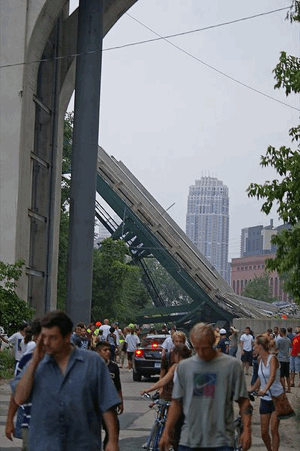
The 2007 bridge collapse in Minneapolis sparked much debate over our crumbling infrastructure. (Credit Wikimedia)
YOUNG: From the Jennifer and Ted Stanley Studios in Somerville, Massachusetts, this is Living on Earth. I’m Jeff Young. The economy’s teetering and the election is nearing. President Obama is betting big on infrastructure.
OBAMA: I am announcing a new plan for rebuilding and modernizing America's roads and rails and runways for the long-term. I want America to have the best infrastructure in the world!
YOUNG: The President wants 50 billion dollars fast to build out and repair thousands of miles of roads and rails. Melissa Lafsky tells us that infrastructure is sorely in need of a little TLC. She edits the blog ‘The Infrastructurist.’ And, Lafsky says the president’s plan has big implications for the environment, as well.
LAFSKY: One of the interesting aspects about this proposal is that it’s integrating rail and air travel into the federal highway and service transportation program. So, traditionally, ever since the 50’s, the U.S. has had the federal highway transportation program which has been obviously very focused on highways.
And, so, what we’re doing now is basically integrating larger rail projects like high-speed rail, as well as, aviation projects and putting it all under the same umbrella as a federal transportation program. So, what that could do is essentially, it could drastically impact our urban planning, our fuel emissions. I mean, trains are electric, they run on electricity. So, our carbon output as a nation, if we all shifted more towards rapid transit, could really make an impact on our environmental status in this country.
YOUNG: So, a lot of focus here on rails but what about runways? And airports? What are the environmental implications of what the president is talking about there?
LAFSKY: Well there could be vast environmental implications, particularly with NexGen, which is the modernized air traffic control system that routes planes via satellite. And it can have a dramatic impact on the fuel efficiency of flights, particularly by streamlining when planes take off and land. And, just from a passenger perspective, it could dramatically decrease delays, but we could cut an enormous amount of fuel by installing this system and having it as our nationwide air traffic control system.

The 2007 bridge collapse in Minneapolis sparked much debate over our crumbling infrastructure. (Credit Wikimedia)
YOUNG: You know, one thing that I find a little puzzling about this, is we’re talking about, in some cases, maintenance and repair, which isn’t that the kind of stuff we’d normally do via the transportation bill? And, by the way, what ever happened to that? Wasn’t Congress supposed to re-authorize that highway-spending bill?
LAFSKY: Well, you’ve really hit the crux of the matter. The transportation bill has been on life support for about a year. It expired and it has been getting these short-term extensions, because basically, if it’s allowed to completely expire, then that’s it. The spigot is been turned off, and there is no federal transportation funding for maintenance of roads, bridges, tunnels and more. Now, the reason that a new transportation bill has not been passed is because there is so much contention in Congress about how to fund it.
So, Obama has come up along and put forth some very interesting proposals, but the issue still remains…how will it be paid for?
YOUNG: And there’s a bit of an environmental twist here as well because, as I understand it, he wants to pay for some of this infrastructure investment by-- yoink-- taking away some subsidies from the oil and gas industry.
LAFSKY: Yes, eliminating tax breaks for oil and gas. And, that would cover, according to what has been released so far, that would cover the first 50 billion. So, there would be this first kick-start of around 50 billion dollars just to get us going on the roads, rails and runways. And, then the rest of the funding, it’s still a bit up in the air where it would come from. And, there’s also the fact that oil and gas companies, they have a pretty powerful lobbying group, and they have a lot of clout in Congress. And, they are certainly unhappy at the idea of paying higher taxes that will go directly towards funding this proposal. So, it’s definitely going to be a very contentious topic.
YOUNG: So, this looks iffy, on the hill. The transportation bill is, in your words, on life-support. So, what’s your hunch? Will these things the president’s proposing here come to pass?
LAFSKY: I think maybe the full extent of the funding may not happen. The 50 billion dollars of initial investment? That might be pretty tough to get through. It is a bit of our political reality. what do voters vote on? They vote on gas taxes, they vote on, ‘what have you done for me lately?’ And, there is a lack of larger vision in our political climate, but I’m optimistic about it.
YOUNG: Melissa Lafsky is editor-in-chief of the Infrastructurist dot com. Thanks very much!
LAFSKY: Thank you!
[MUSIC: David Byrne/Brian Eno “I Feel My Stuff” from Everything That Happens Will Happen (Todomundo Records 2010)]
Fishy Situation
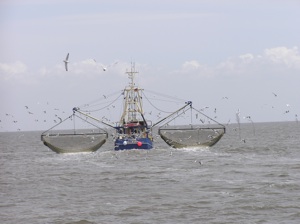
Crab boat working in the North Sea. (Wikimedia Commons)
YOUNG: You might not have heard of the Marine Stewardship Council, but if you’ve shopped for seafood at a Whole Foods or WalMart lately you’ve probably seen its work. The MSC puts those blue check mark labels on seafood that’s deemed sustainably harvested—a sort of eco-seal of approval. But an opinion piece in the journal Nature says the MSC is –quote—“failing to protect the environment and needs radical reform.” Jennifer Jacquet is the lead author; she’s a researcher at the University of British Columbia Fisheries Centre.
JACQUET: What we think is wrong is that the rules of the MSC for certification are too loosely worded, and can be loosely interpreted by third-party certifiers, the ones who actually come in and do the certifying. So, the MSC, they grant the logo once these third-party units say, ‘yeah, the fishery is good, go ahead and drop the logo on it.’ We’d like to see those rules tightened up so that those third-party certifiers, which operate for-profit, and have a financial incentive to certify the fishery, have less room to wriggle around in and certify anything that comes their way.
YOUNG: So, the folks who really do the down-in-the-trenches work on certifying, they stand to make money by saying yes, and that’s part of the problem here.
JACQUET: Exactly. There’s a financial incentive to certify a fishery. It’s a very hard problem to get around, but that is currently the way the market is structured.
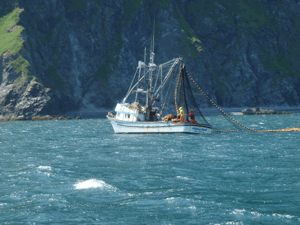
Fishing for Salmon. (Wikimedia Commons)
YOUNG: And, another thing you raise here is that they don’t really address fisheries where the intent is really not for you and I to eat that fish, it’s for that fish to be fed to another fish, or something like that…
JACQUET: That’s right. The end use of the product really isn’t considered. And, they would say that’s very democratic. That anyone can apply for certification. But the problem is that fisheries are applying that actually turn their product into fish meal, to feed to livestock and to farm fish. And this, in and of itself, is unsustainable.
YOUNG: So, give me an example of that.
JACQUET: Well, a recent example is the certification of Antarctic krill. Earlier this summer the MSC certified a fishery for Antarctic krill and that fishery is turning the product into fishmeal and fish supplements to feed some consumers and also farmed fish. Antarctic krill forms the basis of the marine food web in the Antarctic. And the Antarctic, if you can try to imagine this, is only ten percent of the global ocean, but supports 50 percent of the globe’s marine mammals. So, this is a majorly important species to those animals, and we’re taking them and turning it into feed for domestic animals.
YOUNG: Jacquet and her co-authors say several fisheries certified by the MSC are not truly sustainable. The authors say Pacific Hake and Bering Sea Pollock stocks are in decline. And not enough is known about a population of the so-called Chilean Sea Bass.
Jacquet says it sends the wrong signal to consumers.
JACQUET: I know consumers want sustainable seafood. There are two options if you want sustainable seafood. You can reform the fishing industry to make it sustainable-- that’s ideal, right-- but that will take a long time. Fisheries are really in big trouble. Or, you could re-define sustainability to fit the current seafood industrial model. And, that’s what we’re worried is happening with the current MSC process.
YOUNG: So what should those of us who are just going to the store and buying fish…do?
JACQUET: Ally yourself with a retailer, perhaps more than an eco-label, and make it known to your local fish counter that sustainability is important to you. I mean, we don’t want to completely undermine the issue that consumers are looking for guilt-free products. That’s a really good thing, and hopefully it can drive industry. But, on the other hand, we want to make consumers aware that what they’re being told, and what they’re getting are not the same thing, and that issue of deception is really important in the marketplace.
YOUNG: Jacquet’s Nature piece is signed by some big names in fisheries science. We asked the Marine Stewardship Council to respond. Kerry Coughlin, MSC’s regional director for the Americas, denied there’s anything fishy about the Council’s certification.
COUGHLIN: The standard by which we measure fisheries for sustainability, it's a very rigorous process. I would say that it is not at all loosely applied. Independent certification teams do the assessments, they’re on site, they look at all available data, and there’s opportunity for public comment, there’s stakeholder involvement, and it’s maintained through a series of governance that allows for checks and balances. So, it’s a very scientific and robust program. It won’t satisfy every person’s agenda, and I think that was the case with this opinion piece.
YOUNG: These third-party certifiers, don’t they have a financial incentive to certify the fishery?
COUGHLIN: As far as the certifiers being financially motivated, they’re working under pretty strict scientific parameters, by which they measure the fisheries, and again are peer reviewed by another set of independent experts.
YOUNG: Coughlin says the MSC follows United Nations guidelines on certification, which is why they do not consider the end use of fishery products such as krill.
COUGHLIN: That is not within the scope of the MSC program. The MSC’s interest is, regardless of what that fish is being used for, is it being harvested sustainably? And, in the case of krill, the answer was ‘yes’.
YOUNG: It seems to me that you’re dismissing this as the opinions of just a few. Doesn’t it say something that big names in the field saw the need to criticize the council in Nature, which is one of the most prestigious science journals?

Crab boat working in the North Sea. (Wikimedia Commons)
COUGHLIN: The Marine Stewardship Council works with hundreds of scientists around the globe, and a lot of those scientists would disagree with the handful that were writing in Nature. But, at this point, we don’t see that it would be beneficial to the program and to the sustainable seafood movement to make any changes based on the criticism in the Nature piece.
YOUNG: What’s your concern here about the potential impact on consumer confidence in your labeling?
COUGHLIN: We certainly hope that the opinion piece in Nature doesn’t undermine consumer confidence, because there’s no reason for consumers to question whether a fishery is sustainable if it has been certified to the Marine Stewardship Council’s standard.
YOUNG: That’s Kerry Coughlin defending the Marine Stewardship Council. You can decide for yourself: read more at our web site L-O-E dot org and share your thoughts on our Facebook page. It’s PRI’s Living on Earth.
[MUSIC: Jacob Fred Jazz Odyssey “Sensation Of Seeing Light” from Stay Gold (Royal Potato Family 2010)]
YOUNG: In a moment, how environmental issues could help tip an important political race in New Orleans. Stay tuned to Living on Earth!
[MUSIC: Either Orchestra: “The (One Of A Kind) Shimmy” from Mood Music For Time Travellelrs (Accurate Records 2010)]
Related link:
Read the Marine Stewardship Council's response to the Nature article
The Big Easy's Big Decision
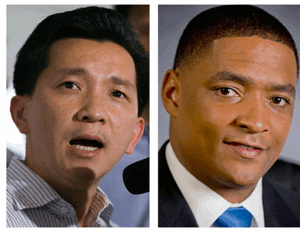
Republican incumbent Ahn "Joseph" Cao (left) faces tough competition in a majority Democratic district from Cedric Richmond.
YOUNG: It’s Living on Earth. I’m Jeff Young. New Orleans was still on the road to recovery from Hurricane Katrina when BP spilled its oil. And, now that it’s election season, the city’s residents are looking back at their problems, ahead to where they need to go— and who should lead them.
New Orleans is in the state’s Second congressional district where Ahn “Joseph” Cao won office in 2008. He was the first Vietnamese-American in Congress-- a Republican representing a majority black and Democratic district. This year, the self-described environmentalist Cao faces a serious challenge. Living on Earth’s Mitra Taj tells us the storm and the spill pose tough decisions for voters in the Big Easy.
[FAINT TALKING AND WALKING SOUNDS]
TAJ: When David Fountain came home after Katrina, he decided to turn his house in the upper ninth ward into an informal museum.
FOUNTAIN: Now, come on, come on, come on, come on!
[DOOR OPENS]
TAJ: It’s a folk art celebration of New Orleans, and a place to reflect on the city’s losses to Hurricane Katrina. A bright yellow Mardi Gras costume rests in a corner, a voodoo priestess’s coffin juts out of a wall, and news clippings of the devastation are everywhere.
[TALKING ABOUT MAKESHIFT BURIAL]
TAJ: Katrina changed pretty much everything in New Orleans, but five years on, it’s still unclear what kind of mark it will end up leaving on politics. New priorities have emerged, and who votes for who could also be changing.
.gif)
Congressman Cao (in yellow shirt) speaks to the crowd at the landfill protest in front of New Orleans City Halll. (Photo: Huu Nguyen)
FOUNTAIN: Since Katrina, we see so much corruption going on, you know, you don’t know whether or not you’re voting for the right person or not. I don’t know. I don’t know anything anymore.
TAJ: The second congressional district used to be a safe seat for Democrats, and for one Democrat in particular: Bill Jefferson, Louisiana’s first black representative. He served nine terms before being indicted on corruption charges. Now David Fountain, a black Democrat, says he’s going to vote for the man that won the 2008 election against Jefferson: Joseph Cao, a Vietnamese-American Republican.
FOUNTAIN: I think he doing a beautiful job. I think he doing a very good job.
TAJ: Fountain said he first met Cao in 2006, when he helped fight a 100-acre-wide landfill proposed in New Orleans East.
[PROTESTORS SHOUTING “DON’T DUMP ON ME, DON’T DUMP ON ME!”]
TAJ: The landfill was going to absorb the city’s post-Katrina ruins. And it was sited just upstream from New Orleans’ Vietnamese-American community, one of the first neighborhoods to come back after the storm.
NGUYEN: I think what happened was the powers that be didn’t realize that we had returned. They thought they could do it before, you know, without us being there opposing it. They didn’t realize that we were already there.
TAJ: Father Vien Nyugen was a priest at the Mary Queen of Vietnam church. He now teaches at New Orleans’ Notre Dam seminary. He says back then Joseph Cao had recently scratched his plans to become a priest in order to practice law. Cao’s career path would change course again when Japanese-American Congressman Mike Honda of California, visited the activists at church. Father Nguyen…
NGUYEN: And I remember it was a Sunday, and there was one member of the community who stood up and said, ‘My parents fought a landfill in 1990, I fought a landfill in 1997, now 2006 my children are having to fight this landfill. It’s a shame, how can we stop this?’ And I remember Mike Honda’s response saying, ‘You need to be involved in the political process, you need to have someone in office so that that person can stop it at the beginning.’ And that’s when Joseph Cao, that day he said ‘I will do it.’
TAJ: On Capitol Hill, Cao led FEMA reforms and pushed out a billion dollars for rebuilding in New Orleans. And when BP spilled oil in the Gulf, he famously told BP America president Lamar McKay that he wasn’t thinking about asking him to resign.
CAO: In the Asian culture we do things differently. During the Samurai days we just give you a knife and ask you to commit hara-kiri.
TAJ: But Cao’s improbable rise to national politics could be brief; unlike the last election, this year he faces tough competition.
ANNOUNCER: Please, a loud round of applause, for none other than Cedric Richmond, our soon-to-be Congressman!
[APPLAUSE, CHEERS]
TAJ: After winning the Democratic primary, Cedric Richmond, a young black state legislator, celebrated with supporters at a hotel downtown.
RICHMOND: It’s not going to be easy road. We’re going to go up against the Republican Tea Party extremists who will do and say anything. They think that this seat belongs to them, but what we know is that this seat belongs to the people.
[APPLAUSE]
TAJ: Richmond’s opponent Joseph Cao is far from a Tea Party Republican. He voted for the Democrats’ financial reform package and boasts how much federal money he delivered the district. But he voted against health care reform, and against the president’s economic stimulus, which funneled about $80 billion to green projects.
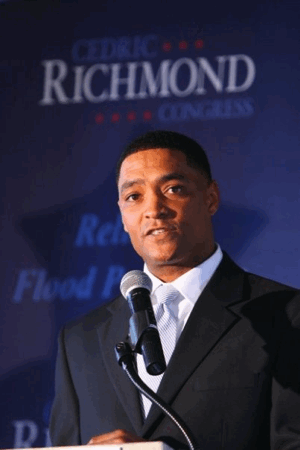
Louisiana state legislator Cedric Richmond says if elected to he'll work to create green job opportunities for New Orleanians. (Courtesy of Cedric Richmond for Congress)
Cedric Richmond says Louisiana needed some of that money, and in his 11 years in the state legislature, he voted to pass Louisiana’s solar tax credit program, which offers the biggest incentives in the country. He also voted for minimum ethanol and bio-diesel standards for gasoline. Green jobs, Richmond says, could be the future for New Orleans.
RICHMOND: We don’t need to be stuck on tourism, so if we could diversify a little bit, with green jobs, with manufacturing, and some other things, I think we’re moving in the right direction.
TAJ: Both candidates are quick to emphasize job creation, but when it comes to how rising temperatures and sea levels could affect the district, their answers vary.
Richmond told me climate change isn’t really on his radar. Cao says it’s on his, but last year when the House passed a cap-and-trade bill to limit greenhouse gases emissions, he voted “no.”
CAO: I represent 750 thousand people. Many of that 750 thousand depends on the jobs that comes from oil and gas that comes from indirect jobs related to oil and gas. And with post-Katrina reconstruction, I could not force my people to pay higher fuel prices. And when I say “my” I’m implying the second district, because often times when people interpret the word “my” they’re thinking about Vietnamese-American.
TAJ: Race continues to be on people’s minds here. This is one of a couple dozen “majority-minority” districts, redrawn in the 1960s to encourage minority representation in Congress. Since Katrina, more whites than blacks have returned to New Orleans, but black registered voters are still thought to make up a majority in the district, and are still a powerful political force.
[TALKING AND TV SOUNDS]
TAJ: On a recent evening in a house in the upper ninth ward, Gwen Johnson talked politics with one hand on the TV remote. She was waiting to watch her husband, percussionist Smokey Johnson, on a Katrina anniversary show.
JOHNSON: You see in the wheelchair? You see him, he’s playing the tambourine. You see, he’s a drummer but he plays percussion instruments now, so yeah, there he is.
[MUSIC ON TV]
TAJ: Smoky used to be Fats Domino’s drummer, so after Katrina the Johnsons’ were invited to live in the Musicians’ Village, a small cluster of homes built by Habitat for Humanity. She says if it weren’t for the project they wouldn’t have come home to New Orleans at all.
Johnson says she won’t vote for Cao because he’s a Republican, because he voted against health care, and because he’s not doing enough to bring recovery money into black neighborhoods.
JOHNSON: The uptown side of Canal Street is doing pretty good. They have three or four hospitals; they have shopping centers. We have nothing out here. Only thing we have are Dollar stores and Walgreens.
TAJ: Johnson says black representatives have tended to look out for black communities, and in November she says she’ll be voting for Cedric Richmond.
JOHNSON: But I don’t have to vote for a black person, but I will vote for a person I think that’s going to help us. He doesn’t have to be black. But it just so happen, the best man is black.
VILES: Cedric Richmond seems very committed to supporting President Obama’s agenda.
TAJ: Aaron Viles is the campaign director for the Gulf Restoration Network, based in New Orleans. The non-profit doesn’t endorse political candidates but Viles will be voting for Cedric Richmond. He says Richmond will support Obama’s plans to eventually address climate change, and Cao’s “no” vote on the House bill sent a strong message about his priorities.
VILES: The impacts of climate change are already being felt here, we’re seeing sea level rise that’s exacerbating our coastal wetlands crisis. We’re seeing stronger storms. I mean, the idea that it’s too expensive to start acting on climate change, the reality is that’s a very tired narrative.
TAJ: But other voters remain focused on the lingering challenge of recovery. Democrat David Fountain says Cao’s got a good start. He wants him to keep improving levee and hurricane preparedness systems, and to continue to find the funding so that everyone can come home.
FOUNTAIN: The main thing still to be done, we have a lot of people that want to come home, and they still can’t come home. That’s the saddest thing about where we at now, that a lot of people still cannot come home.
TAJ: On November 2nd, voters will decide who can best address the city’s post-Katrina priorities. For Living on Earth, I’m Mitra Taj in New Orleans.
YOUNG: You can hear more of Mitra’s interviews at our website, L-O-E dot org.
[MUSIC: Dirty Dozen Brass Band “Right On” from What’s Goin On (Shout Factory 2006)]
Related links:
- **WEB EXTRA** Click here to listen to Mitra Taj's interview with Congressman Cao.
- **WEB EXTRA** Cedric Richmond talks with Mitra Taj after his primary victory speech.
- Like most Louisiana politicians, both candidates support lifting the moratorium on offshore drilling. Click here to read Cao's reasons why.
- Click here to read an story about the candidates in a recent debate.
- The League of Conservation Voters gave Congressman Cao a 43% rating on environmental issues. Click here to learn about key votes.
- Cedric Richmond on the issues.
- Joseph Cao on the issues.
- Click here to learn more about New Orleans' Vietnamese-American community since Katrina and the BP oil spill.
Science Note
YOUNG: Just ahead – why the city of Cleveland plans to snoop into people’s garbage. But first, this Note on Emerging Science from Amie Ninh.
[THEME]
NINH: The saying “I feel your pain” is meant to convey that someone understands your emotions. But new research shows this common phrase may be a bit more complex than you think.
Humans have the capacity for empathy, but Italian scientists say the intensity of your feelings toward others may depend on the color of their and your skin.
When we see or think about someone in physical pain, our nervous system naturally responds as if we feel that pain ourselves.
Researchers applied this idea of pain empathy in a small study. Some three dozen people, half Italian and half African, watched short films of needles pricking both black and white hands. The researchers recorded the response activity of a muscle in participants’ hands to determine how much they reacted to the pain shown on the film screen. They found that people responded more strongly when the character in pain was of the same race as they were, while characters of a different race evoked less of a response.
If the films showed an alien violet hand, however, participants were more likely to respond physically then if hand were of the other race. The researchers say this implies that humans empathize by default unless racial prejudice interferes. The scientists believe the study could have implications for doctor-patient relations. If doctors have stronger racial biases, they may under-treat the pain of patients of other races. And despite obvious differences in cultural and racial mix between the U.S. and Italy, the scientists say they would expect similar results if the study were conducted here.
In a perfect world, the color of our skin wouldn’t matter. But here on earth, the truth can be painful. That’s this week’s Note on Emerging Science. For Planet Harmony and Living on Earth, I’m Amie Ninh.
[THEME]
YOUNG: Amie reports for our sister program, Planet Harmony, which welcomes all and pays special attention to stories affecting communities of color. Log on and join the discussion at My Planet Harmony dot com.
Related link:
Abstract in Current Biology
High Tech Trash
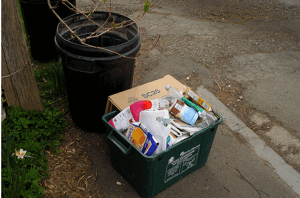
Recycling on the curb. (Photo: net_efekt)
YOUNG: Cleveland, Ohio is hoping some high tech can turn the city’s trash into cash. Soon, residents will receive new recycling bins embedded with radio frequency ID chips. The RFID chips are like those used to nab shoplifters. But in Cleveland- they’ll be used to keep tabs on who’s not recycling. Ron Owens is in charge of the project - he’s Cleveland’s Commissioner of Waste – Mr. Owens, welcome to Living on Earth!
OWENS: Hey- glad to be here!
YOUNG: Well, how does this work? How are you going to know if someone isn’t recycling?
OWENS: Well actually the way we set our system up is that we have a two-cart system. We have a grey cart for your regular garbage and then we have a blue cart for your recycling. And, inside those carts will be our RFID code, which will basically be used for us to track how often this particular service is provided to certain areas. And, it will also track the performance of my employees.
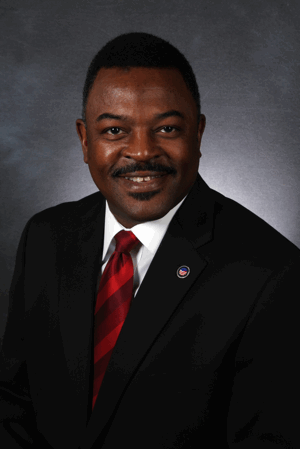
Cleveland's Commissioner of Waste, Ron Owens.
YOUNG: Uh huh. So, if the chip detects that the grey bin is getting a lot of use but the blue bin isn’t, you know they’re not recycling.
OWENS: Yeah, I mean what we’re looking for is sort of like a threshold, at least once or twice a month that people are recycling. So, if we go maybe like five weeks in a row and notice that a particular resident hasn’t set out their recycling can, that next time we go out and collect their rubbish, if there still isn’t a recycling can out there, then we will actually open up their bag of trash that’s out there, take a photo and then that will be our proof.
YOUNG: Mm hmm. And what do you do with that evidence?
OWENS: The city of Cleveland for the last 20 or so years that I’ve been involved with the division of waste collection, has had this ticketing process for those people that violate our waste laws. Actually, only difference it is going to be with this system is that we are collecting the recyclables separately. Right now, if you don’t put your trash out properly in the city of Cleveland, you may be subject to a fine.
You can be subject for a fine for putting your trash out too early, not taking your containers back in a timely manner. If you have excess trash out there, those are the individuals that we’re actually looking to give tickets to. But everybody else we’re definitely going to try to educate them to properly utilize these containers.
YOUNG: Have you ticketed people before for not recycling, though?
OWENS: No, not for recycling we haven’t. That’s a new law that we had put in place to help us enforce this program.
YOUNG: How much would the ticket be?
OWENS: Um, the penalty is basically a hundred dollars per incident.
YOUNG: A hundred bucks? If I get a parking ticket for a hundred bucks, I generally think that’s pretty steep!
OWENS: Yeah, it is a pretty steep fine. And that’s one of the things we want to do is encourage the residents to properly utilize these carts. And if you properly set out your garbage container and then you properly separate your recycling and put it into your blue container, then you wouldn’t have to worry about that hundred dollar fine.
YOUNG: Why is it necessary to threaten people with a hundred dollar fine for not recycling?
OWENS: We had a pilot program back in October of 2007 that we started with and we had approximately 20 percent participation. And, once we’ve seen that voluntarily there is a number of folks that will not use this cart properly, then we had to figure out we needed enforcement. And here’s another reason why we need to properly utilize these containers: we’re looking at generating some new energy for the city of Cleveland.
What I mean by that ‘new energy’ is potentially going to a waste-energy facility. And we’re going to take our garbage from that point and turn it into steam, which is going to turn some turbines and generate some electricity. And, that’s another reason why we need to separate those materials which are more recyclable from your regular garbage, because we want to gain as much financial gain off of this amount of material that we have as possible.
YOUNG: What’s your level of concern about generating some backlash here?
OWENS: When the law was passed, a lot of folks focused on the fine piece of it, and then they looked at the RFID tag and though ‘oh, wow, Big Brother is looking into us,’ and no it’s not. It’s not Big Brother. All it is, is a performance-based system that we’re putting in to make sure that we achieve those efficiencies.
It’s really not us going to be going through the trash. That’s the last thing that we want to do is to have to sort through your trash to see if there is recyclables in there or not. Again, once we get out there and explain to the residents, which we’re currently working on an educational plan right now. We’re going to have the carts with us, we’re going to have our facts with us, and we’re going to lay it all out for them. So, they won’t have to be concerned about us going through their trash, or any concerns about privacy issues.
YOUNG: And, give us a sense of how much money is at stake here…
OWENS: Well, this program is going to cost us about 25 million dollars over the next four to five years. So, although it is an expensive program, we believe with the efficiencies and savings that we’re looking at, we definitely are going to recover this cost. We’re currently being paid some 27 dollars per ton for our recyclables.
So, what that means is, for every ton of recyclables that I save from going out into the landfill, I make 27 dollars on that, as well as I save the 33 dollars that I would be paying to dispose of that material. So when you add the 27 plus that 33, that’s actually a 60 dollar savings. We get rid of some 220 thousand tons of trash annually.
Forty two percent of that waste is recyclable. If you can compare 42 percent of that waste with somewhere around a 100 thousand tons, if I’m able to collect that 100 thousand tons times that 60 dollars that I save- you know, that’s a substantial amount of money that’s really being save to our general fund budgets.
YOUNG: Do you think this is going to catch on? Are other cities going to be doing this?
OWENS: Yes, as a matter of fact, there are a number of other cities: Charlotte, North Carolina, places in Washington DC, and quite a number of other places that are actually utilizing technology similar to this.

Recycling on the curb. (Photo: net_efekt)
YOUNG: Well, Mr. Owens, one more thing…I understand some congratulations are in order. The American Public Works Association named you National Manager of the Year in Public Waste, is that correct?
OWENS: Yes. I have received a number of rewards in regards to this. It’s truly good. This just shows that we’re heading in the right direction with the things that we are trying to do with the city of Cleveland.
YOUNG: You’re at the top of the heap, one might say.
OWENS: (laughs) The top of the heap, okay, yes sir.
YOUNG: Ron Owens, Commissioner of Waste in Cleveland, Ohio. Thank you very much!
OWENS: Thank you, it was a pleasure being here.
[MUSIC: Karl Denson “Dance Lesson #2” from Dance Lesson #2 (Blue Note Records 2001)]
YOUNG: Just ahead- a trip to the far north to record a vanishing language and way of life - keep listening to Living on Earth!
[MUSIC: Monty Alexander: “Soulful Strut” from Monty Meets Sly And Robbie (Telarc Records 2000)]
Related links:
- See what Cleveland is doing
- Cleveland's waste collection website
- See what Arlington, VA is doing
- See what San Francisco, CA is doing
- See what Houston, TX is doing
Planning for Rising Water
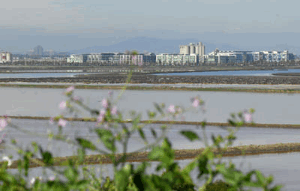
A network of salt production ponds lie below sea level next to San Francisco Bay in Redwood City, Calif. Developers want to turn the area into a small city. ( Dan Honda/Bay Area News Group)
YOUNG: It’s Living on Earth. I’m Jeff Young.
[FERRY BUILDING CLOCK RINGS, WAVES]
YOUNG: Most people think of sea level rise as a problem for future generations to deal with. But in San Francisco, planners warn it’s just around the corner. Sea level rise is already happening. Predictions about how much to expect over the coming century vary greatly. The IPCC said oceans could rise two and a half feet. Many other scientists say the rise might be more than twice that.
In San Francisco four and a half feet of sea level rise could put more than one hundred thousand Bay Area homes at risk of flooding. Yet developers there still want to build on low-lying land with million-dollar views. Reporter Julia Scott of San Francisco’s KALW looks at how climate change could change the places we call home.
[TREASURE ISLAND WAVES LAPPING]
SCOTT: At first glance, you couldn’t pick a worse place to build a city than Treasure Island. The island was thrown together out of soft Bay mud in 1935 for the Golden Gate International Exposition. It would liquefy in a major earthquake.
[SOUNDS OF CHILDREN FROM THE BOYS AND GIRLS CLUB, WAVES]
SCOTT: Yet it’s also home to around fourteen hundred people. They bring their kids to the local Boys and Girls Club after school … And they shop at the island’s only convenience store on their way home.
[OUTDOOR SOUNDS]
SCOTT: But Bay Area housing officials believe it could be much more. Engineer Dilip Trivedi works for a group of firms hired to come up with a vision for Treasure Island.
TRIVEDI: As you look out here as we stand, you look at Alcatraz, you look at Angel Island, you look at the Golden Gate and the Bay Bridge. And of course the fabulous, any time of the day or night, you come and you see San Francisco’s downtown skyline here. I mean, it is just an amazing vista.
SCOTT: When Trivedi looks around he sees up to 8,000 homes, five high-rises, public parks, restaurants and a ferry terminal by 2030.
TRIVEDI: Folks are going to come off the Treasure Island free shuttle from the homes itself to that center point on the island and take the ferry, take the bus, kiss and ride, carpools… That’s going to be pretty much downtown.
SCOTT: San Francisco officials hired Trivedi and his engineering firm, Moffatt & Nichol, to make this island habitable and secure in a world with rising sea levels. Developers will have to spend more than a billion dollars on infrastructure before the first home is even built.
The first challenge they’ll deal with is hard to miss. Treasure Island is only two feet above the federal government’s predicted flood line. One corner of the island is already regularly flooded by winter waves.
[TREASURE ISLAND WAVES]
SCOTT: To deal with the threat of flood, they decided to raise the island itself. Hundreds of tons of dirt, packed tight, will make the ground as solid and resilient as the bedrock of neighboring Yerba Buena Island. It will lift the building foundations three feet above the highest 100-year tide.
Trivedi says that even when the sea rises over the next century, the homes will be high and dry.
TRIVEDI: What we are effectively saying is that when the sea level rise itself is 36 inches, the community on Treasure Island is far better than most places along even downtown San Francisco and most places along the Bay themselves.
SCOTT: What made them choose 36 inches? Basically, it’s an educated guess. Cities are free to build by the Bay and choose how to protect the development. Some building proposals are factoring in sea level rise, some not at all.
They can’t get much federal guidance, either. When it comes to building levees, no agency considers the risks of sea level rise - not FEMA, and not the Army Corps of Engineers.
[SOUND OF SALT HARVESTER]
SCOTT: A few miles away in San Francisco’s South Bay, developers are eyeing another waterfront opportunity. One company wants to build the biggest development in half a century on top of a network of salt ponds. These ponds have made salt for 150 years. A salt harvester ploughs across a cloudy pond. These Cargill salt ponds are a stone’s throw away from Silicon Valley.
SMITH: Our vision is to maximize the potential of the site to bring sorely needed housing to a very jobs-rich environment.
SCOTT: That’s David Smith, a vice president with project developer DMB Associates.
SMITH: Between Silicon Valley and San Francisco, this is one of the greatest economic engines in our country.
SCOTT: Where some see a moonscape of red-tinted salt ponds and white slush, Smith sees up to 12,000 homes and one million square feet of office space – along with acres of wetland restoration, playing fields, and a school.
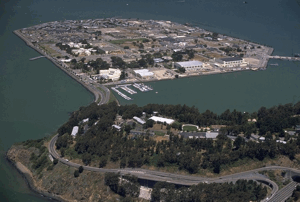
San Francisco's Treasure Island is susceptible to flooding and sea level rise, but developers have a plan to raise the island and build up to 8,000 homes. (Courtesy City of San Francisco)
Unfortunately, most of the site is no more than a foot above sea level. Some of it is even below. That means it would need a levee. And some levee sections would be as high as ten feet, turning the property into a kind of bathtub. That’s a design issue Smith says his company is trying to overcome.
SMITH: If you’re right up against the area, it will be an attractive thing, but you’re not going to want to see a levee and not be able to peek over to the Bay until the third story of your house.
SCHNEIDER: The same questions facing Bay Area cities also confront planners all over the world. Ten percent of the world’s population lives within low-lying coastal zones.
SCHNEIDER: Sooner or later, somebody’s going to have to deal with the backside of our short-term behavior.
SCOTT: The late Dr. Stephen Schneider was a world-renowned climate scientist at Stanford University. He passed away not long after this interview was recorded.
SCHNEIDER: We’re talking something like 15 to 25 feet of potential sea level rise over many centuries if you substantially melt Greenland and just the West Antarctic, the peninsula part. So we are talking about a complete rewrite of the map of the world, it just takes a long time.
SCOTT: As cities begin to plan for sea level rise, they may even re-conceive the nature of settlements, says Will Travis, executive director of the San Francisco Bay Conservation and Development Commission.
TRAVIS: We aren’t building communities anymore; we’re building long-term campgrounds. And if you think of it that way, we may decide to build in a different way. We may decide that the best thing to do is have buildings that are specifically designed to only last 50 or 100 years, and then they can be decomposed, they can be disassembled, they can be moved away.
SCOTT: Back at Treasure Island the redevelopment project doesn’t include floating homes. But Engineer Dilip Trivedi’s team is coping with uncertainty by leaving a 300-foot buffer around the entire island – so future generations can build a sea wall.

A network of salt production ponds lie below sea level next to San Francisco Bay in Redwood City, Calif. Developers want to turn the area into a small city. (Dan Honda/Bay Area News Group)
TRIVEDI: At a point in time where you need 50-feet-high levees on Treasure Island, I mean, there are a lot more problems that are going to happen all around the world, if you will. But within the Bay, Treasure Island will be a pretty safe place to be at.
SCOTT: It’s hard to imagine San Francisco underwater. But it’s a scenario that experts say we ought to be thinking about today. And how we think it through could determine whether our current coastal zones continue to thrive, or are left behind. For Living on Earth, I’m Julia Scott.
BirdNote (R) - Tiny Dancers

Red-necked Phalarope (Photo: Tom Grey©)
YOUNG: Today we’re happy to hatch a new feature, BirdNote (R). In this fledgling edition, BirdNote’s Michael Stein introduces us to some whirling dervishes of the far north.
[RED-NECKED PHALAROPES AND WIND ON THE OCEAN]
STEIN: Phalaropes are sandpipers that make their living from the sea. After breeding on the Arctic tundra, they migrate to the open ocean. They remain there through the winter, feeding on tiny crustaceans and other marine animals, making an amazing adaptation to a completely different environment.
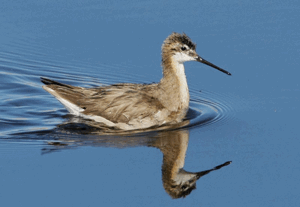
Wilson’s Phalarope (Photo: Tom Grey ©)
Wherever you see them, these little birds will be pecking at the surface of the water. But watch for a bit, and you may see a method of feeding unique to phalaropes. They begin to twirl on the surface like little ballerinas, spinning and pecking, again and again. What are they doing?
[CALLS OF RED-NECKED PHALAROPES]

Red-necked Phalarope (Photo: Tom Grey ©)
STEIN: A phalarope spins around once per second, each bird spinning only left or right. As it does so, it forces water away from itself on the surface, causing an upward flow from as deep as a foot or more.
With this flow, of course, come the tiny animals on which it feeds. Furthermore, as it opens its bill, it creates still another water current that carries prey into its throat. One of the rewards of observing birds closely is that you see the fascinating strategies they use to survive and thrive.
[RED-NECKED PHALAROPES]
YOUNG: That’s Michael Stein for BirdNote (R). For pictures and more information, go to our website L-O-E dot org.
[MUSIC: Jolly Rogues: “Greenland Whale Fishery” from The Road To Boston (The Jolly Rogues 2003)]
Related links:
- BirdNote (R) “Phalaropes, Spinners on the Sea” was written by Dennis Paulson.
- Red-necked Phalarope audio provided by The Macaulay Library of Natural Sounds at the Cornell Lab of Ornithology, Ithaca, New York
Native Traditions and Climate Change
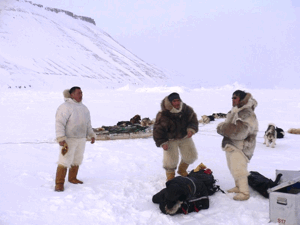
The Inughuit use traditional methods like sled dogs to hunt for the meat that makes up the bulk of their diet.
YOUNG: Well, according to that old sea-shanty – “Greenland is a dreadful place. It’s a land that’s never green, where there’s ice and snow and the whale-fishes blow, and the daylight’s seldom seen.”
Not exactly vacation land. But we caught up with a researcher from the UK’s Cambridge University as he was packing for a yearlong stay in Greenland. Stephen Pax Leonard is an anthropological linguist, and for the next year he’ll be in one of the northern most settlements on earth.
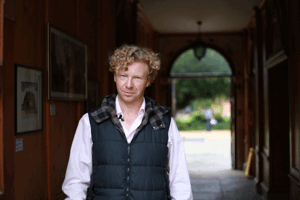
Stephen Leonard will spend the next year living in the Inughuit community to document their language for future generations.
He’ll live with the Inughuit, subsistence hunters in north-west Greenland, learn their language, and document their culture as they, and Greenland, head for big changes. Dr. Stephen Pax Leonard joins us from Cambridge. Welcome to the program!
LEONARD: Well, thank you very much.
YOUNG: Well, tell us about the Inughuit and how they live, and what’s compelling you to visit.
LEONARD: Well, this is one of the last hunter-gather societies left in Greenland. And, although these people live in the remote northwest corner of Greenland, they really represent the cultural center. In the sense that there’s a tradition of storytelling which really goes back to the basis of Greenlandic culture and narrative.
The reason why I’m going- there are two reasons, really, in fact- first of all, is to document their language, which is called Inughuitun and second, to record, digitize, archive and ultimately give back to the community a collection of stories and narratives which tell us about this extraordinary arctic societies’ history and identity.
YOUNG: Do they have a written form of their language?
LEONARD: They don’t, no. Standard West-Greenlandic is a written language, but Inughuitun has never been written down. It’s not an indo-European language. This language belongs to the Eskimo-Aleut family. It’s what linguists called an agglutinative language, which means it’s lots of different sorts of affixes glued together. So, if you take, for example the phrase, “otherwise I had planned on going to school,” you would have to say…(SPEAKS IN INUGHUITUN)…
That is…one word, believe it or not. A whole sentence in English is one long word. To break that down, “a-doo-wah” is the word for school, “fim” is the word for building, “mook-kah” is the affix to go to, “nie-ahv” is the affix to intend to, “allu-ah” is the affix otherwise, and then “pungha” at the end is sort of the first-person singular, the I. It’s a completely different way of looking at language, which makes it so very difficult.
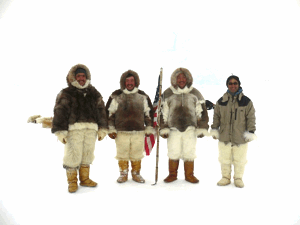
A group of Inughuit men out on a hunting expedition.
YOUNG: I know that in most societies that depend on an oral tradition, it’s powerful, in that it goes back a long way. But it’s fragile, in that it depends on the generational link. What’s the threat to this generation-link for this oral tradition?
LEONARD: This community, this way of life, this culture is all threatened because, actually, of global warming. As I’ve said this is a hunter-gatherer society, and it’s a society that are really very dependent on the hunting of sea mammals. Global warming and the very dramatic climate change in this corner of Greenland is leading to fewer animals in the sea to kill in the first place, but it’s also making the hunting of these animals extremely difficult and dangerous.
And, the reason for that is, this community insists on using very traditional methods. They hunt in kayaks, they use harpoons, and they use dog sleds. And, so really, this entire way of life is threatened. And so now, there’s communities under political pressure to move slightly further south, and if that happens, I think ultimately this community will fragment. And then, the language will be lost. The culture will be lost. And, this history of story telling will go as well, I think.
YOUNG: We read just a few weeks ago in the news of an enormous chunk of ice breaking off of Greenland. Give us a sense of the rate of change that these people are dealing with.
LEONARD: The people that I’ve been speaking to in this community, they are telling me that climate change is happening far faster than any of them believed was possible. That vast iceberg that you refer to, is very close to this community where I’m going. It’s actually slightly further up the coast in an uninhabited region of Greenland.

The Inughuit use traditional methods like sled dogs to hunt for the meat that makes up the bulk of their diet.
The community is telling me that their entire way of life, their culture will simply not be there in ten to 15 years time. And, that’s a problem for them. But it’s also a problem for the Greenlandic government because if they are no longer able to survive by hunting sea mammals and so on and so forth, then the Greenlandic government is sort of obliged to provide welfare, medical benefits, and so on to this community and that’s hugely expensive because they’re so very remote.
YOUNG: So that’s the political pressure for them to move?
LEONARD: That’s the political pressure. And there’s great tension in the community because these people don’t want to leave. This is the place where their ancestors lived for hundreds of years. And the alternative, if they’re to leave this community, they’ll probably end up being housed in modern flats in the capital in Nuuk, which is fifteen hundreds of miles away, and they would live a completely different life. And, within no time at all, their language would be completely gone because it’s only spoken by one thousand people.
YOUNG: And, how do you prepare for a trip like this? A year in a pretty hostile environment, one where I’m guessing, a good chunk of the year is going to be in complete darkness?
LEONARD: That’s correct. There are an enormous number of challenges. The average temperature in the winter is –25 degrees Celsius, which means it falls at about –40 degrees Celsius, which I think is more or less about the same degrees in Fahrenheit at that point. The sun goes down for the last time on the 24th of October, and doesn’t rise again until the 8th of March.
That’s three and a half months of darkness. That’s probably going to be difficult to deal with. But I think, perhaps, the biggest challenge, personal challenge, will probably be the diet. There’s only one ship of fruit and vegetables that goes to this place a year, so I will be eating seals, whales, narwhals, walruses, just as this community does. And, that’s not something I’ve done before, so I’m sure, going to be quite a shock to the system as well.
YOUNG: And, how are your whaling skills? Are you going to be a useful person up there?
LEONARD: Not initially, no. I’m going to be in impediment, initially, I’m sure. But, I very much need to learn to live the way they live. And, the reason for that is, a lot of this tradition of storytelling, these stories and narratives and myths, and Inuit drum songs- they’re often performed on hunting expeditions, actually. And, so, I obviously need to be a part of that. And, I need to make myself as useful as possible on those hunting trips, as soon as possible (laughs).
YOUNG: It sounds like an amazing adventure and opportunity, but it also sounds like it’s going to be tinged with a great deal of sadness, knowing that what you’re documenting is, in all likelihood, a way of life that’s nearing an end.
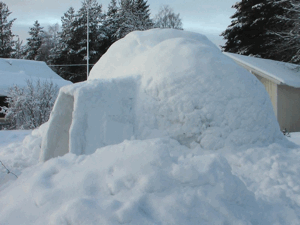
The Inghuit use tents for hunting but they will build an igloo in a pinch.
LEONARD: Yes, I think so. Obviously, I can’t stop global warming. And there’s not really anything I can do to save some of these traditions, really. But, what I can do is go there and I can record this material. I can digitize it archive it. But more importantly, what I would like to do is actually give it back to the community and publish it in their language, in Inughuitun, which has of course, not been done before.
Previously, what people have done is, they have collected some of this material, and it’s normally been published in Danish, and it’s not really been made very accessible to these people. So, it’d be great to give that back to the community. And, even if this way of life does disappear in ten or 15 years as people are telling me, then at least we’ll have some record of this extraordinary culture.
YOUNG: Stephen Pax Leonard an anthropological linguist from the University of Cambridge… Good luck!
LEONARD: Thank you very much!
[MUSIC: John Mock: “The Greenland Whale Fishery” from Ship In Full Sail (Cumberland Records 2009)]
Related link:
Read more about Stephen Leonard at Scott Polar Research Institute website
YOUNG: Living on Earth is produced by the World Media Foundation. Our crew includes Bobby Bascomb, Eileen Bolinsky, Bruce Gellerman, Ingrid Lobet, Helen Palmer, Jessica Ilyse Smith, Ike Sriskandarajah, and Mitra Taj, with help from Sarah Calkins, and Sammy Sousa. And, this week we welcome our new interns, Nora Doyle-Burr and Honah Liles.
Audio of protestors in our piece from New Orleans provided by the documentary A Village Called Versailles which aired on PBS's Independent Lens in May 2010. Jeff Turton is our technical director. Alison Lirish Dean composed our themes. Steve Curwod is our executive producer. You can find us anytime at L-O-E dot org, and check out our Facebook page. It’s PRI’s Living on Earth. I’m Jeff Young. Thanks for listening.
ANNOUNCER: Funding for Living On Earth comes from the National Science Foundation supporting coverage of emerging science. And Stonyfield farm, organic yogurt and smoothies. Stonyfield pays its farmers not to use artificial growth hormones on their cows. Details at Stonyfield dot com. Support also comes from you, our listeners. The Ford Foundation, The Town Creek Foundation, The Oak Foundation—supporting coverage of climate change and marine issues. The Bill and Melinda Gates foundation, dedicated to the idea that all people deserve the chance at a healthy and productive life. Information at Gates foundation dot org. And Pax World Mutual Funds, integrating environmental, social, and governance factors into investment analysis and decision making. On the web at Pax world dot com. Pax World for tomorrow.
ANNOUNCER 2: PRI – Public Radio International
Living on Earth wants to hear from you!
Living on Earth
62 Calef Highway, Suite 212
Lee, NH 03861
Telephone: 617-287-4121
E-mail: comments@loe.org
Newsletter [Click here]
Donate to Living on Earth!
Living on Earth is an independent media program and relies entirely on contributions from listeners and institutions supporting public service. Please donate now to preserve an independent environmental voice.
NewsletterLiving on Earth offers a weekly delivery of the show's rundown to your mailbox. Sign up for our newsletter today!
 Sailors For The Sea: Be the change you want to sea.
Sailors For The Sea: Be the change you want to sea.
 The Grantham Foundation for the Protection of the Environment: Committed to protecting and improving the health of the global environment.
The Grantham Foundation for the Protection of the Environment: Committed to protecting and improving the health of the global environment.
 Contribute to Living on Earth and receive, as our gift to you, an archival print of one of Mark Seth Lender's extraordinary wildlife photographs. Follow the link to see Mark's current collection of photographs.
Contribute to Living on Earth and receive, as our gift to you, an archival print of one of Mark Seth Lender's extraordinary wildlife photographs. Follow the link to see Mark's current collection of photographs.
 Buy a signed copy of Mark Seth Lender's book Smeagull the Seagull & support Living on Earth
Buy a signed copy of Mark Seth Lender's book Smeagull the Seagull & support Living on Earth

